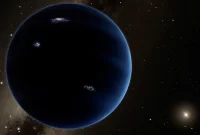This Jupiter-sized world narrowly avoided destruction when its star died … as our sun should in about five billion years.
Perhaps the luckiest planet in the Milky Way is moving about 6,500 light years from Earth, towards the center of our galaxy: a vast gaseous world that was almost destroyed by its dying star.
Astronomers spotted the system, described in the scientific journal Nature, when the planet and its star distorted starlight being observed. The distant world in question is the size of Jupiter and revolves around a tiny stellar corpse – a dark, white Earth-sized dwarf who once looked a lot like our sun. As this star grew older, it evolved into a red giant. It then ejected all of its outer layers, forming a planetary nebula. The white dwarf is what results from these transformations, a high-density celestial object, and the final stage in the evolution of not very massive stars. This complex and fascinating process can easily destroy the planets in orbit.
“This planet could easily have been destroyed,” explains Juliette Becker of Caltech, who was not involved in its detection. “She very likely narrowly escaped destruction.”
If the planet had evolved a little closer to its star, it undoubtedly would have had a more dramatic fate, similar to that which awaits the Earth and its immediate vicinity when our sun, dying, becomes a red giant.
“This system is very similar to the predictions we make for the final evolution of our solar system,” says study author David Bennett of NASA’s Goddard Space Flight Center.
Observing this planetary system also helps scientists understand how planets can survive the violent death of their star. If it turns out that intact planets are common around white dwarfs, and then there would be “more planets than we think,” says astronomer Scott Gaudi of Ohio State University.
“This would mean that our count of the planets in the galaxy has probably been underestimated so far,” he says.
A FLAMBOYING END
As stars age, they lack hydrogen, triggering a sequence of events that can be very dangerous for all surrounding planets. This is the fate our sun will face in about five billion years, and when it does, Earth will be in trouble.
Slowly, the Sun lacking in hydrogen will turn into a red giant. While inflating, it will engulf and reduce to ashes Mercury then Venus. The Earth, if it escapes it, will almost certainly be torn apart by the increasing gravity of the Sun. Mars is probably far enough away to survive this first wave of destruction. In the outer solar system, the four giant planets will be pushed into more distant orbits, although in some special cases they could be completely ejected from the solar system or even engulfed by the sun.
“There are a lot of strange things that can happen to planets when their star is changing,” Becker points out. “The process is quite violent, especially for the planets in the inner part of the system.”
About a billion years after becoming a red giant, our sun will collapse into a white dwarf that will be about half of its original mass, compressed into a sphere the size of Earth. This process can also wreak havoc on neighboring planets. All the worlds left behind will end up in a very different cosmic quarter. In addition, even if the four giant planets in our solar system survive these upheavals, there is a good chance that they will wander the vastness for billions of years, randomly encountering wandering stars.
SURVIVE HELL
Even though astronomers believe that planets can survive the chaotic death of their host star, they have not found many examples of planets that actually survived their sun’s collapse. Scientists at Microlensing Observations in Astrophysics first spotted the newly described system in 2010, when the surviving planet and its white dwarf passed a star they were observing.
The way in which the giant planet and the white dwarf distorted the light of the stars observed in the background revealed several fundamental characteristics of this system, including its movement in the sky, the presence of both a star and a planet, and the great orbit of the planet. The observations also helped astronomers calculate the relative masses of the two objects. Called MOA-2010-BLG-477Lb, the system is intriguing to say the least, and it will probably take several years to fully understand it.
“It’s hard to tell the foreground star from the background star when you’re in the presence of such a [gravitational micro lens] phenomenon, because they overlap,” says Bennett. “We have to wait until their paths part.”
In 2015, Bennett and his colleagues used the powerful Keck-II telescope atop Mauna Kea in Hawaii to search for the star. They knew how far the system must have traveled in five years, but they could not find anything that looked like the star they were looking for – just another star, moving in the wrong direction.
The team repeated their observations in 2016 and then in 2018, without success. They knew however that the singular system was there, since its gravity distorted the light of the surrounding stars. As they failed to observe it, Bennett and his colleagues concluded that what they were looking to see was so faint that even a powerful telescope like Keck could not observe it.
“We knew it must have been a star a little less massive than our sun, so we hypothesized a white dwarf,” Bennett explains.
After doing further calculations, the team concluded that the system included a world with a mass similar to that of Jupiter and a white dwarf with a mass about half the mass of our sun. The planet’s orbit carries it at least 2.8 times farther from its star than Earth is from the Sun, placing it roughly in the same location as the asteroid belt in our solar system.
“This planet is where we expect giant planets to form,” says Gaudi. “And it shows that these Jovian analogues can survive the evolution of a star similar to the Sun.”
Somehow, this massive world evolved at a good distance to avoid the deadly consequences of its star’s transformation – a distance that depends not only on the dying star, but also on the characteristics of the planet and movements of neighboring planets that may have existed.
IN SEARCH OF OTHER PLANETS ORBITTING AROUND WHITE DWARVES
Astronomers have already found evidence of planets orbiting white dwarfs, but none of these detections quite resembles that of this system. In 2019, an international team of astronomers spotted a ring of gaseous debris around a white dwarf and speculated that a small, dense planetary remnant could be embedded in the debris – a world destroyed like Earth will be. Several other debris have also been identified: these are the jagged remains of planets and asteroids with unfortunate fates.
Last year, another team using the TESS space telescope, NASA’s essential tool in the hunt for exoplanets, identified a planet – a giant world – orbiting a white dwarf in just 34 hours of observation. . This planet is so close to its host star that it “would certainly have been swallowed up during the red giant phase,” says Becker. “Which means she had to migrate to her current location after the star became a white dwarf.” ”
All of these observations, in addition to the recently discovered system, suggest that some planets can survive the evolutionary transformations of their host stars, at least for some time. However, the processes that determine whether a planet survives are still unclear.
NASA’s Nancy Grace Roman Space Telescope, scheduled to launch in the mid-2020s, is expected to reveal many planets orbiting white dwarfs. In addition, as astronomers glimpse other planets surrounding these stellar corpses, they will learn more about how the agony of a star alters the architecture of planetary systems, allowing us to contemplate the future of our own Solar system.
The recently discovered system could even see additional planets encircling the white dwarf. While our own planet will not survive the Sun’s dramatic death – at least not in any recognizable state – maybe other worlds will survive, and the solar system will survive, but in another form.



